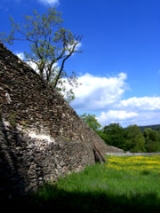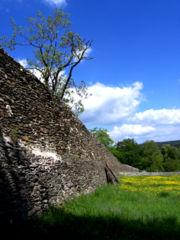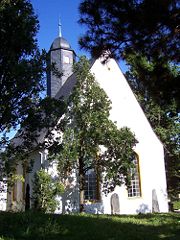
Grünhain-Beierfeld
Encyclopedia
Grünhain-Beierfeld is a town in the district of Erzgebirgskreis
in Saxony
, Germany
lying 8 km east of Aue
. It came into being on 1 January 2005 through the merger of the town of Grünhain and the community of Beierfeld.
, in the east on Elterlein
, in the south on Raschau
, in the southwest on Schwarzenberg
and in the west on Bernsbach
and Lößnitz
.
, Beierfeld was laid out as a forest village (Waldhufendorf
). The town’s name hints at Bavaria
n colonists (the first two syllables, “Beier” are pronounced the same way as the German word Bayer, which means “Bavarian”). In 1233, Beierfeld became a monastic domain with Meinhard II of Wirbene’s endowment of the Grünhain Monastery
. The abbot at Grünhain thereby held jurisdiction over the community until the Reformation
and he received rent and socage
from it.
When mining
came, however, the transition from a purely agricultural
community to an industrially
based one began. The cutlery makers’ rising fortunes in the 17th and 18th centuries as well as the plating industry’s in the 19th century established the town’s main fields of business. From beginnings in producing handmade house and kitchen machines grew factory production in large enterprises by the beginning of the 20th century.
 Grünhain had its first documentary mention in 1150. The location on the salt road from Halle (Saale)
Grünhain had its first documentary mention in 1150. The location on the salt road from Halle (Saale)
to the Preßnitzer Pass and on to Bohemia
convinced Cistercian monks to come and found a monastery here. In 1276, Grünhain was granted town rights. Until the 15th century, the monastery extended its sphere of influence, mainly through donations. At the onset of the Reformation, the monastery held sway over more than 56 villages and three towns. The Reformation and the Thirty Years' War
were the monastery’s downfall.
, tin
and iron
, marble
was also later quarried. Mining continued until 1920. Mining also yielded the place’s name, which refers to an ore washing operation on a ridge.
On 1 January 2005 came Grünhain’s and Beierfeld’s amalgamation, along with a name change to Grünhain-Beierfeld.


The three festivals are held in turn, one each year.
View from the Spiegelwald over Grünhain (in the background is the Schatzenstein)
); however, the most important connections are the road to Schwarzenberg
, near which runs the Bundesstraße 101, and the road to Zwönitz
to a feeder road to the Bundesautobahn 72
.
Erzgebirgskreis
Erzgebirgskreis is a district in the Free State of Saxony, Germany. It is named after the Erzgebirge , a mountain range in the southern part of the district which forms part of the Germany–Czech Republic border...
in Saxony
Saxony
The Free State of Saxony is a landlocked state of Germany, contingent with Brandenburg, Saxony Anhalt, Thuringia, Bavaria, the Czech Republic and Poland. It is the tenth-largest German state in area, with of Germany's sixteen states....
, Germany
Germany
Germany , officially the Federal Republic of Germany , is a federal parliamentary republic in Europe. The country consists of 16 states while the capital and largest city is Berlin. Germany covers an area of 357,021 km2 and has a largely temperate seasonal climate...
lying 8 km east of Aue
Aue
Aue is a small town in Germany at the outlet of the river Schwarzwasser into the river Mulde in the Ore Mountains, and has roughly 18,000 inhabitants. Aue was the administrative seat of the former district of Aue-Schwarzenberg in Saxony, and is part of the Erzgebirgskreis since August 2008...
. It came into being on 1 January 2005 through the merger of the town of Grünhain and the community of Beierfeld.
Location
The town lies in the northeast of the district. The highest point in the municipal area is the Spiegelwald (forest) at 738 m above sea level.Neighbouring communities
In the north, the town borders on ZwönitzZwönitz
Zwönitz is a town in the district Erzgebirgskreis, in the Free State of Saxony, Germany. It is situated 9 km south of Stollberg, and 24 km southwest of Chemnitz.- References :...
, in the east on Elterlein
Elterlein
Elterlein is a town in the district of Erzgebirgskreis, in the Free State of Saxony, Germany. It is situated in the Ore Mountains, 10 km west of Annaberg-Buchholz.- References :...
, in the south on Raschau
Raschau
Raschau is a former municipality in the district of Aue-Schwarzenberg in Saxony, Germany. Since 1 January 2008, Raschau and Markersbach have formed the municipality Raschau-Markersbach.- Location :...
, in the southwest on Schwarzenberg
Schwarzenberg, Saxony
Schwarzenberg is a town in the district of Erzgebirgskreis in Saxony’s Ore Mountains, near the German–Czech border. The town lies roughly 15 km southeast of Aue, and 35 km southwest of Chemnitz....
and in the west on Bernsbach
Bernsbach
Bernsbach is a community in the district of Erzgebirgskreis in the Free State of Saxony in Germany that together with its constituent community of Oberpfannenstiel has roughly 4,700 inhabitants.- Geography :...
and Lößnitz
Lößnitz
Bergstadt Lößnitz , sometimes also called Muhme for its age, is a town in the district of Erzgebirgskreis, Saxony, Germany, and belongs to the Town League of Silberberg...
.
Constituent communities
Grünhain-Beierfeld has three of these:- Beierfeld
- Grünhain
- Waschleithe
Beierfeld
The area around Beierfeld was settled in the 12th century. As with most other places in the Ore MountainsOre Mountains
The Ore Mountains in Central Europe have formed a natural border between Saxony and Bohemia for many centuries. Today, the border between Germany and the Czech Republic runs just north of the main crest of the mountain range...
, Beierfeld was laid out as a forest village (Waldhufendorf
Waldhufendorf
The Waldhufendorf is a form of rural settlement established in areas of forest clearing with the farms arranged in a series along a road or stream, like beads on a chain...
). The town’s name hints at Bavaria
Bavaria
Bavaria, formally the Free State of Bavaria is a state of Germany, located in the southeast of Germany. With an area of , it is the largest state by area, forming almost 20% of the total land area of Germany...
n colonists (the first two syllables, “Beier” are pronounced the same way as the German word Bayer, which means “Bavarian”). In 1233, Beierfeld became a monastic domain with Meinhard II of Wirbene’s endowment of the Grünhain Monastery
Monastery
Monastery denotes the building, or complex of buildings, that houses a room reserved for prayer as well as the domestic quarters and workplace of monastics, whether monks or nuns, and whether living in community or alone .Monasteries may vary greatly in size – a small dwelling accommodating only...
. The abbot at Grünhain thereby held jurisdiction over the community until the Reformation
Protestant Reformation
The Protestant Reformation was a 16th-century split within Western Christianity initiated by Martin Luther, John Calvin and other early Protestants. The efforts of the self-described "reformers", who objected to the doctrines, rituals and ecclesiastical structure of the Roman Catholic Church, led...
and he received rent and socage
Socage
Socage was one of the feudal duties and hence land tenure forms in the feudal system. A farmer, for example, held the land in exchange for a clearly defined, fixed payment to be made at specified intervals to his feudal lord, who in turn had his own feudal obligations, to the farmer and to the Crown...
from it.
When mining
Mining
Mining is the extraction of valuable minerals or other geological materials from the earth, from an ore body, vein or seam. The term also includes the removal of soil. Materials recovered by mining include base metals, precious metals, iron, uranium, coal, diamonds, limestone, oil shale, rock...
came, however, the transition from a purely agricultural
Agriculture
Agriculture is the cultivation of animals, plants, fungi and other life forms for food, fiber, and other products used to sustain life. Agriculture was the key implement in the rise of sedentary human civilization, whereby farming of domesticated species created food surpluses that nurtured the...
community to an industrially
Industry
Industry refers to the production of an economic good or service within an economy.-Industrial sectors:There are four key industrial economic sectors: the primary sector, largely raw material extraction industries such as mining and farming; the secondary sector, involving refining, construction,...
based one began. The cutlery makers’ rising fortunes in the 17th and 18th centuries as well as the plating industry’s in the 19th century established the town’s main fields of business. From beginnings in producing handmade house and kitchen machines grew factory production in large enterprises by the beginning of the 20th century.
Grünhain

Halle, Saxony-Anhalt
Halle is the largest city in the German state of Saxony-Anhalt. It is also called Halle an der Saale in order to distinguish it from the town of Halle in North Rhine-Westphalia...
to the Preßnitzer Pass and on to Bohemia
Bohemia
Bohemia is a historical region in central Europe, occupying the western two-thirds of the traditional Czech Lands. It is located in the contemporary Czech Republic with its capital in Prague...
convinced Cistercian monks to come and found a monastery here. In 1276, Grünhain was granted town rights. Until the 15th century, the monastery extended its sphere of influence, mainly through donations. At the onset of the Reformation, the monastery held sway over more than 56 villages and three towns. The Reformation and the Thirty Years' War
Thirty Years' War
The Thirty Years' War was fought primarily in what is now Germany, and at various points involved most countries in Europe. It was one of the most destructive conflicts in European history....
were the monastery’s downfall.
Waschleithe
Waschleithe had its first documentary mention in 1531. Already by the 13th century, mining had begun in the Oswald Valley, where Waschleithe lies. Besides silverSilver
Silver is a metallic chemical element with the chemical symbol Ag and atomic number 47. A soft, white, lustrous transition metal, it has the highest electrical conductivity of any element and the highest thermal conductivity of any metal...
, tin
Tin
Tin is a chemical element with the symbol Sn and atomic number 50. It is a main group metal in group 14 of the periodic table. Tin shows chemical similarity to both neighboring group 14 elements, germanium and lead and has two possible oxidation states, +2 and the slightly more stable +4...
and iron
Iron
Iron is a chemical element with the symbol Fe and atomic number 26. It is a metal in the first transition series. It is the most common element forming the planet Earth as a whole, forming much of Earth's outer and inner core. It is the fourth most common element in the Earth's crust...
, marble
Marble
Marble is a metamorphic rock composed of recrystallized carbonate minerals, most commonly calcite or dolomite.Geologists use the term "marble" to refer to metamorphosed limestone; however stonemasons use the term more broadly to encompass unmetamorphosed limestone.Marble is commonly used for...
was also later quarried. Mining continued until 1920. Mining also yielded the place’s name, which refers to an ore washing operation on a ridge.
Amalgamations
On 1 January 1999 came Waschleithe’s amalgamation with Beierfeld.On 1 January 2005 came Grünhain’s and Beierfeld’s amalgamation, along with a name change to Grünhain-Beierfeld.
Culture and sightseeing


Museums
- Zur Heimatecke exhibition in Waschleithe
- Herkules-Frisch-Glück demonstration mine in Waschleithe
- Beierfeld Red Cross Museum
Buildings
- Remains of the Grünhain Cistercian monastery
- Ruins of Saint Oswald’s Church (Dudelskirche) in Waschleithe
- Peter-Pauls Kirche in Beierfeld
- St. Nicolai Kirche in Grünhain
- König-Albert-Turm (King Albert Tower)
Regular events
- Löffelmacherfest in Beierfeld (spoonmakers’ festival)
- Klosterfestspiele in Grünhain (“monastery festival games”)
- Harzerfest in Waschleithe
The three festivals are held in turn, one each year.
Transport
Grünhain-Beierfeld is not connected to any other community by Federal Highway (BundesstraßeBundesstraße
Bundesstraße , abbreviated B, is the denotation for German and Austrian national highways.-Germany:...
); however, the most important connections are the road to Schwarzenberg
Schwarzenberg
- People :* House of Schwarzenberg, Frankish and Bohemian aristocratic family which was first mentioned in 1172** Karl Philipp, Prince of Schwarzenberg , Field Marshal in Austrian service during the Napoleonic Wars...
, near which runs the Bundesstraße 101, and the road to Zwönitz
Zwönitz
Zwönitz is a town in the district Erzgebirgskreis, in the Free State of Saxony, Germany. It is situated 9 km south of Stollberg, and 24 km southwest of Chemnitz.- References :...
to a feeder road to the Bundesautobahn 72
Bundesautobahn 72
is an motorway in Germany. Construction of the autobahn started in the 1930s, but was halted by the outbreak of World War II. Due to the division of Germany, a part of the autobahn lay in ruins until after German reunification.- Exit list :...
.
Sons and daughters of the town
- Johann Hermann Schein (1586-1630), ThomanerchorThomanerchorThe Thomanerchor is a boys' choir in Leipzig, Germany. The choir was founded in 1212. At present, the choir consists of 92 boys from 9 to 18 years of age...
Kantor, born in Grünhain - Fritz Körner (1873-1930), Ore Mountain dialect poet, born in Waschleithe, died in Beierfeld
- Liselotte Pieser (1917-1998), economist and politician (CDU), Member of the BundestagBundestagThe Bundestag is a federal legislative body in Germany. In practice Germany is governed by a bicameral legislature, of which the Bundestag serves as the lower house and the Bundesrat the upper house. The Bundestag is established by the German Basic Law of 1949, as the successor to the earlier...
, born in Beierfeld
People with connections to the town
- Kunz von KaufungenKunz von KaufungenKunz von Kaufungen , was a German knight and military commander. A veteran of the Hussite wars, he also fought for Frederick II, Elector of Saxony against Frederick's brother Duke William III during the Saxon Fratricidal War...
(ca. 1410-1455), mastermind of the Altenburg Princely Robbery, was caught near Waschleithe - Johann Gabriel Löbel (1635–1696), glassworks owner and pig ironPig ironPig iron is the intermediate product of smelting iron ore with a high-carbon fuel such as coke, usually with limestone as a flux. Charcoal and anthracite have also been used as fuel...
producer, died in Grünhain - Thomas KöhlerThomas KöhlerThomas Köhler is an East German former luger who competed during the 1960s.He won three Winter Olympic medals in men's luge with two golds and one silver ....
(1940- ), double Olympic medallist in lugeLugeA Luge is a small one- or two-person sled on which one sleds supine and feet-first. Steering is done by flexing the sled's runners with the calf of each leg or exerting opposite shoulder pressure to the seat. Racing sleds weigh 21-25 kilograms for singles and 25-30 kilograms for doubles. Luge...
, lived for a time in Beierfeld - Ortrun EnderleinOrtrun EnderleinOrtrun Enderlein is an East German luger who competed in the 1960s. She was born in Werdau. She won the gold medal in the women's singles event at the 1964 Winter Olympics in Innsbruck...
(1943- ), luge competitor, worked at the Beierfeld measuring instrument works

